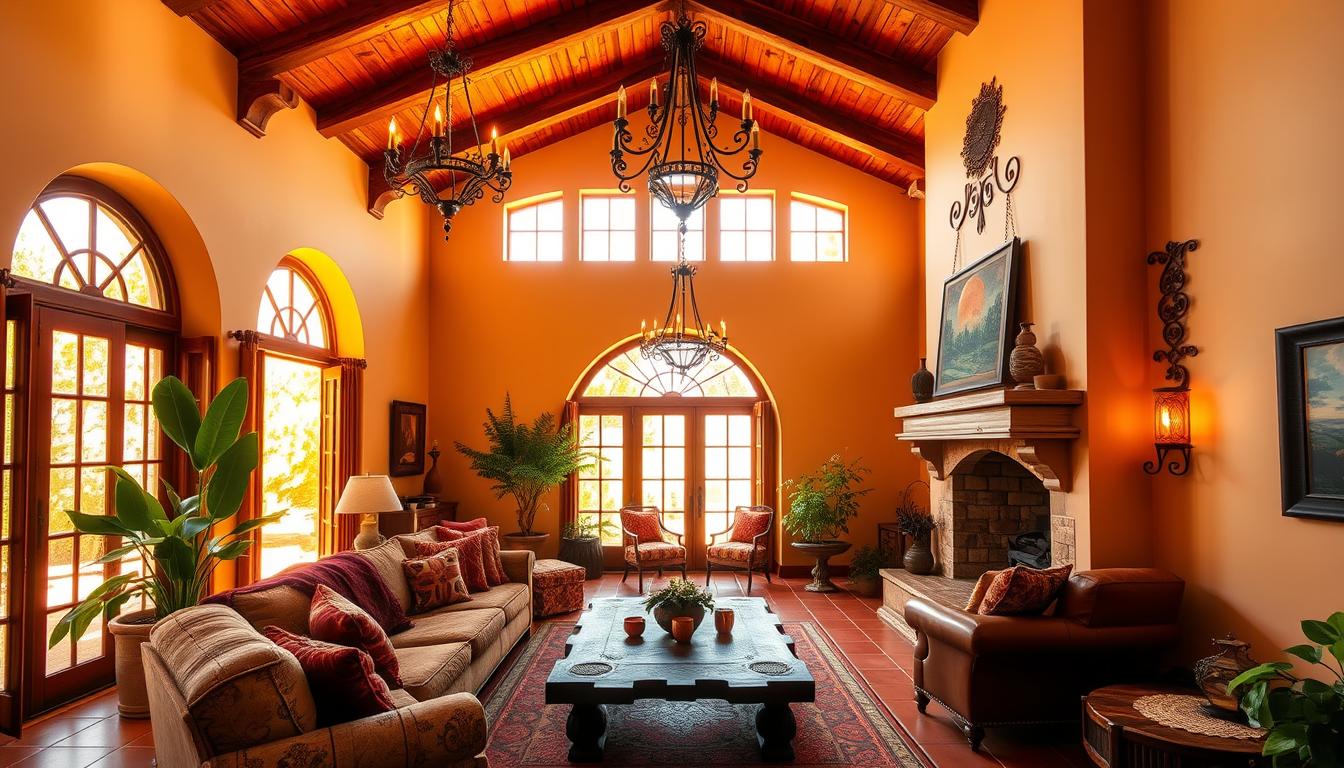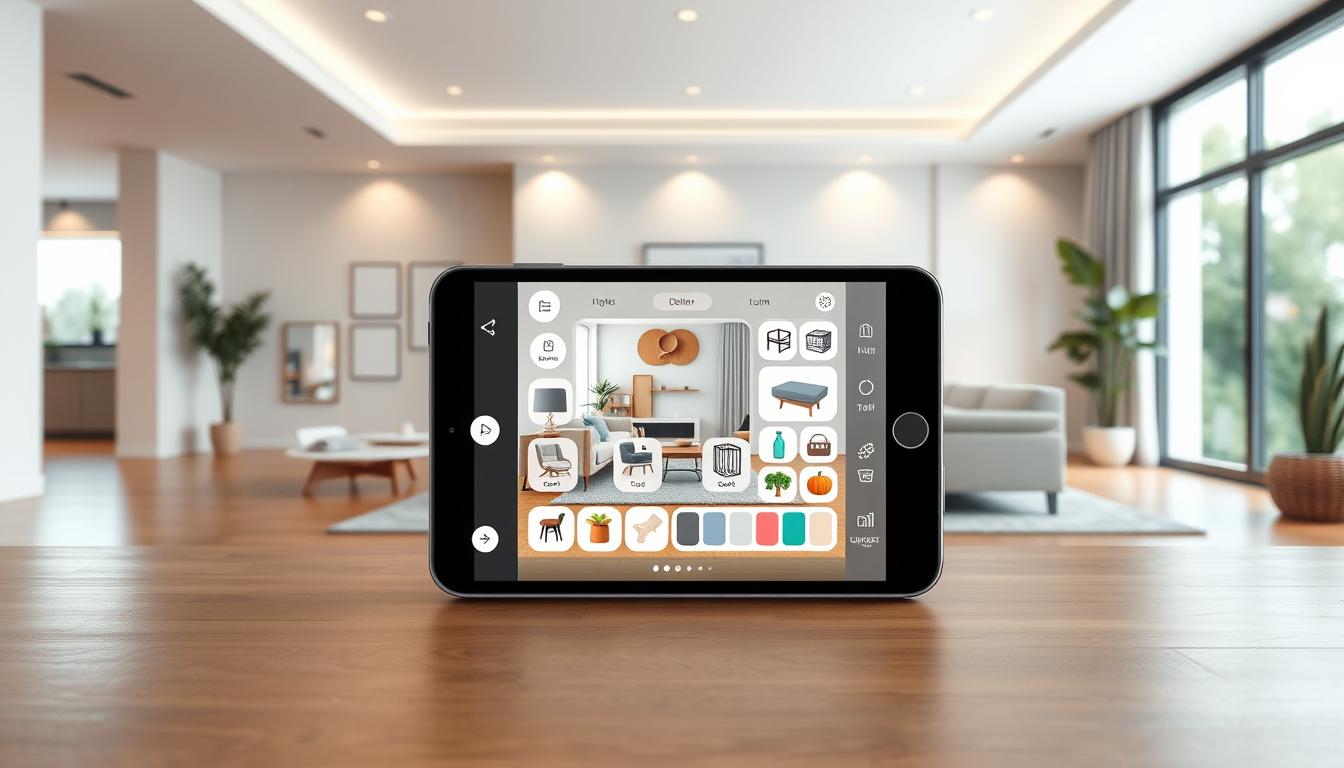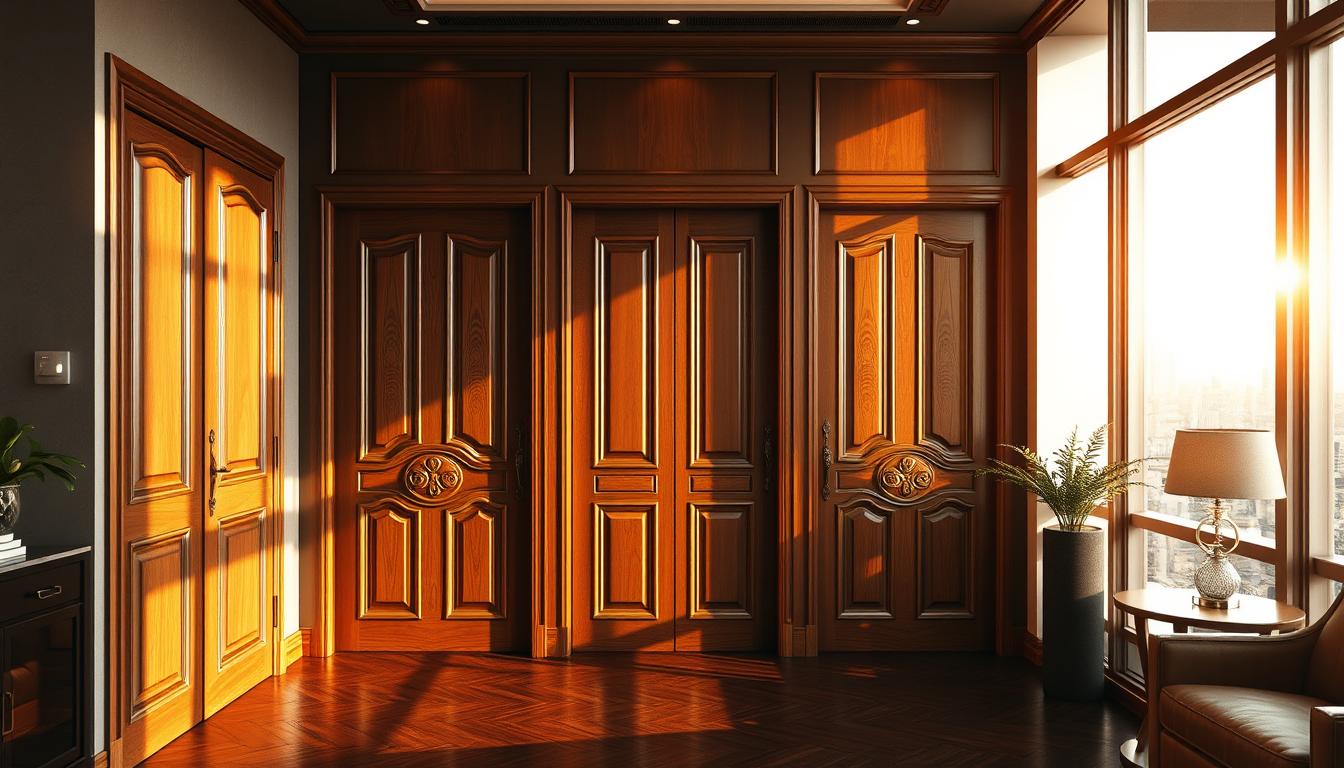Did you know Spanish-style homes are becoming more popular? They’re loved for their warm, welcoming look. This trend isn’t just about old times; it’s about making a cozy, elegant living space that shows off a rich culture.
We’ll show you how to design a beautiful spanish style home interior. You’ll learn about key elements, colors, furniture, and decor. Our guide will give you the ideas and tips you need to get that authentic look.
Key Takeaways
- Understand the core elements of a Spanish-inspired decor
- Learn how to choose the right color palette for your space
- Discover furniture selection tips for an authentic Spanish look
- Explore decorative tips to enhance your home’s elegance
- Get insights into blending traditional and modern Spanish-inspired designs
Understanding Spanish-Style Home Design
Spanish-style homes mix Moorish, Gothic, and Mediterranean styles. This mix has grown over centuries. It reflects Spain’s culture and history.
Key Features of Spanish-Style Architecture
Spanish homes stand out with arches, columns, and ornate tile work. These features add beauty and show Spain’s rich culture.
- Arches: They make doorways, windows, and passageways look grand and elegant.
- Columns: Made from stone or stucco, they support arches and show strength.
- Ornate Tile Work: Known as azulejos, these tiles decorate homes with detailed patterns.
Architects say, “Arches and columns in Spanish homes honor Spain’s architectural past.”
“Spanish homes feel warm and welcoming. This is thanks to their traditional design elements.”
Historical Influences on Spanish Design
Spanish design has been shaped by many styles, like Moorish, Gothic, and Mediterranean. The Moorish influence is seen in tile work and arches. Gothic style is in vaulted ceilings and woodwork.
| Influence | Architectural Features |
|---|---|
| Moorish | Intricate tile work, arches |
| Gothic | Vaulted ceilings, ornate woodwork |
| Mediterranean | Use of natural materials, emphasis on outdoor spaces |
For more on Spanish home design, check out Luxe Interior Co.. They have a detailed guide on adding Spanish style to your home.
Modern Adaptations of Traditional Styles
Today’s Spanish home design keeps traditional elements but adds modern touches. It uses new materials and tech while keeping the Spanish style.
Some modern changes include:
- Using azulejos in new ways, like kitchen backsplashes or bathroom walls.
- Adding sustainable and energy-saving materials to designs.
- Mixing Spanish style with other designs for a unique look.
Knowing Spanish architecture’s history and features helps homeowners create spaces that respect the past and welcome today.
Essential Elements of Spanish-Style Interiors
Spanish-style interiors are cozy and elegant. They use rich colors, textures, and rustic furnishings. These elements make a living space warm and inviting, showing the beauty of Spanish culture.
Emphasizing Warm Colors and Textures
Warm, earthy colors and rich textures define Spanish-style interiors. Colors like terracotta, sienna, and golden brown make spaces welcoming. These hues are paired with textures from wood, stone, and handmade tiles.
Adding different textures through furnishings and decor adds depth. A woven rug warms the floor, while wooden beams add a rustic touch to ceilings.
Incorporating Rustic Furnishings
Rustic furnishings are key in Spanish-style interiors. They bring character and authenticity. Look for pieces in natural materials like wood and iron for a warm feel. Vintage or antique furniture adds history and elegance.
For authentic Spanish-style homes, Luxe Interior Co. offers inspiration and guidance. They help choose the right rustic furnishings.
The Role of Tile and Flooring
Tile and flooring are vital in Spanish-style interiors. Traditional Spanish tiles like Talavera or Saltillo are used. They are beautiful and durable, perfect for busy areas. Tile flooring also ties the home together.
When picking tile and flooring, think about color and texture. Earthy tones and natural textures create a cozy atmosphere. Ornate tile work adds elegance and sophistication.
Color Palettes for Spanish-Style Homes
Designing a Spanish-style home interior starts with the color palette. The right colors bring warmth and hospitality, making your home inviting and true to Mediterranean design.
Earthy Tones and Vibrant Accents
Traditional Spanish homes use earthy tones like terracotta and sienna. These warm colors are balanced by vibrant accents for visual interest. Terracotta tiles add authenticity, used for flooring and decor.
Vibrant colors like cobalt blue and sunny yellow add depth and personality. These colors come from ceramic tiles, textiles, and decorative accessories, making the space lively and welcoming.
Combining Neutrals with Bold Colors
Spanish-style design balances neutral backgrounds with bold colors. Neutrals like beige calm the space, letting bold colors shine. This contrast makes the space visually appealing and dynamic.
For example, a neutral wall can be paired with bold-colored tiles or vibrant textiles for a striking contrast. This adds interest and defines areas in an open-plan space.
Choosing the Right Paint Finishes
The paint finish greatly affects your Spanish-style home’s look. Finishes vary in sheen and durability, fitting different areas of the home.
- Matte Finish: Great for low-traffic areas, it creates a subtle look.
- Satin Finish: Versatile, it’s good for most rooms, balancing looks and durability.
- Gloss Finish: Less common, but adds elegance on trim and decorative elements.
Choosing the right colors and finishes makes your Spanish-style home beautiful and authentic. Whether you prefer earthy tones or bold accents, the right choices will bring your vision to life.
Furniture Selection for Spanish Interiors
Furniture is key to bringing warmth and hospitality into Spanish-style interiors. The right pieces can make you feel like you’re in Spain. They bring history and tradition into your home.
Ideal Materials for Authenticity
To get an authentic Spanish look, choose materials that feel warm and full of character. Solid wood and wrought iron are must-haves. They last long and look great forever.
Wooden furniture, with its detailed carvings, adds a sense of history and skill to your space.
Wrought iron brings elegance and class, perfect for lighting, railings, and decorations. Mixing these materials creates a rich, Spanish look.
Popular Spanish-Style Furniture Brands
Many brands specialize in Spanish design. La Bamba and Arterra are known for their beautiful, functional pieces. They use quality materials and handcraft each item.
“The art of furniture making is not just about creating pieces that are functional; it’s about crafting items that tell a story and evoke emotion.”
Arranging Furniture for Cozy Spaces
Creating cozy, inviting spaces is crucial in a Spanish-style home. Start with a central seating area. Use comfy sofas and chairs around a standout coffee table.
Add warm textiles like throw blankets and rugs to make it even cozier.
- Use a mix of high-backed chairs and sofas to create intimate seating areas.
- Incorporate wooden or wrought iron accent tables to add character.
- Layer lighting with table lamps, floor lamps, and overhead fixtures to create a warm glow.
By carefully choosing and arranging your furniture, you can make your home feel both authentic and welcoming.
Incorporating Spanish-Inspired Decor
The secret to a stunning Spanish-style home is in the details. This includes decorative tiles and statement lighting. To make your space feel real and welcoming, mix traditional elements with your own personal touches.
Decorative Tiles and Authentic Art Pieces
Decorative tiles are key in Spanish design. They bring color, texture, and interest to any room. Think about using traditional Talavera tiles or handmade ceramics in your decor.
Adding authentic art pieces, like vintage Spanish posters or hand-painted canvases, can also elevate your space. Choose art that shows Spain’s rich culture, like scenes of everyday life or landscapes.
The Use of Textiles and Patterns
Textiles are vital in Spanish home decor. They add warmth and depth. Look for fabrics with traditional Spanish patterns, like Moorish designs or floral motifs.
Use these textiles in throw pillows, blankets, or furniture. Mixing different patterns and textures creates a rich look. Feel free to combine bold colors and intricate designs for more interest.
Statement Lighting for Character
Statement lighting is crucial for a room’s feel. In Spanish homes, wrought iron chandeliers and sconces are favorites. They add drama and elegance. Layering different lights, like table lamps or floor lamps, makes the space warm and inviting.
Choose lighting with traditional Spanish details, like intricate metalwork or ornate designs. This will enhance your home’s Spanish style.
Creating Outdoor Spaces in Spanish Style
Spanish-style outdoor spaces are warm, elegant, and blend perfectly with nature. They are more than just an extension of the indoors. They are peaceful havens that show off the beauty of Spanish villa design.
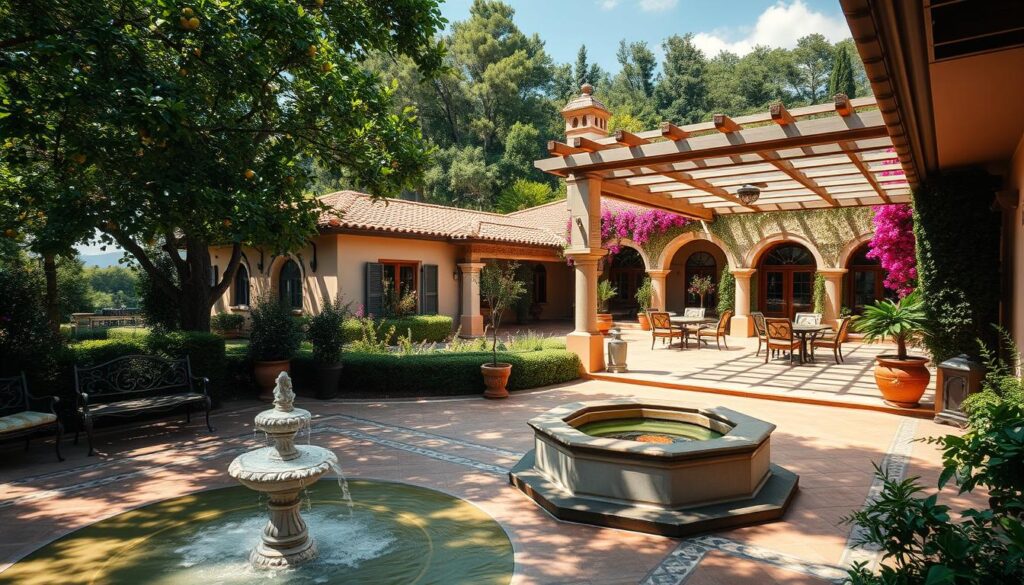
Designing Inviting Patios and Gardens
To make a true Spanish-style outdoor space, start with elements that show Spain’s rich culture. Use traditional materials like terracotta tiles, wrought iron, and stucco.
Make sure to add lush greenery and colorful flowers from the Mediterranean, like olive trees, lavender, and bougainvillea. They bring color and scent to your outdoor paradise.
Choosing Outdoor Furniture and Decor
Choosing the right furniture and decor is key for a true Spanish-style outdoor space. Go for wrought iron or wooden furniture with detailed carvings. These are signs of Spanish design.
Add vibrant textiles, handmade ceramics, and Spanish-inspired art to your space. These elements add depth and character.
“The courtyard, with its fountain and orange trees, is a classic example of Spanish design, creating a serene and inviting atmosphere.” –
Incorporating Water Features
Water features are essential in Spanish-style outdoor spaces, bringing a calming vibe. Think about adding a fountain or a small pond to your design. It becomes a peaceful centerpiece.
The sound of water flowing adds to the sensory experience. It also helps block out noise, making your outdoor space a quiet retreat.
- Surround water features with natural stone or terracotta pots to blend them into the landscape.
- Add lighting to highlight the water feature at night, creating a stunning effect.
With careful design, you can create a beautiful Spanish-style oasis. It extends your living area and boosts your home’s look.
Flooring Options for Spanish-Style Interiors
The flooring in a Spanish-style home is more than just a necessity. It’s a key design element that adds to the ambiance. Traditional tiles are a classic choice, but modern options are also worth exploring.
Traditional Tiles vs. Modern Alternatives
Traditional tiles like terracotta and ceramic are loved for their authenticity and timeless look. Terracotta tiles, for example, add a warm, earthy feel to Spanish interiors. Yet, they need sealing to keep looking good.
Modern options like porcelain tiles and hardwood flooring are durable and easy to care for. Porcelain tiles are great for busy areas because they resist moisture and wear well. Hardwood flooring, though less traditional, brings elegance and can be stained to match Spanish design’s warm tones.
Pros and Cons of Various Materials
Here’s a look at the pros and cons of flooring materials in Spanish-style homes:
| Material | Pros | Cons |
|---|---|---|
| Terracotta | Authentic look, warm tones | Requires periodic sealing, can be porous |
| Ceramic | Versatile, easy to clean | Can appear cold, may lack the authentic feel of terracotta |
| Hardwood | Elegant, can be stained to match Spanish-style tones | More expensive, requires maintenance to prevent scratches |
| Porcelain | Durable, resistant to moisture | Can appear less authentic, may be more expensive than ceramic |
Maintenance Tips for Longevity
To keep your flooring looking great, regular care is key. For terracotta and ceramic, clean them with a mild detergent now and then. Hardwood floors need polishing to avoid scratches and wear. Porcelain tiles, though durable, should also be cleaned often to keep their shine.
Choosing the right flooring and following maintenance tips will help keep your Spanish-style home beautiful and authentic.
Integrating Modern Amenities While Preserving Style
To make a Spanish-style home both true to its roots and modern, we need to find a balance. This balance keeps the home’s character while making it comfortable and practical.
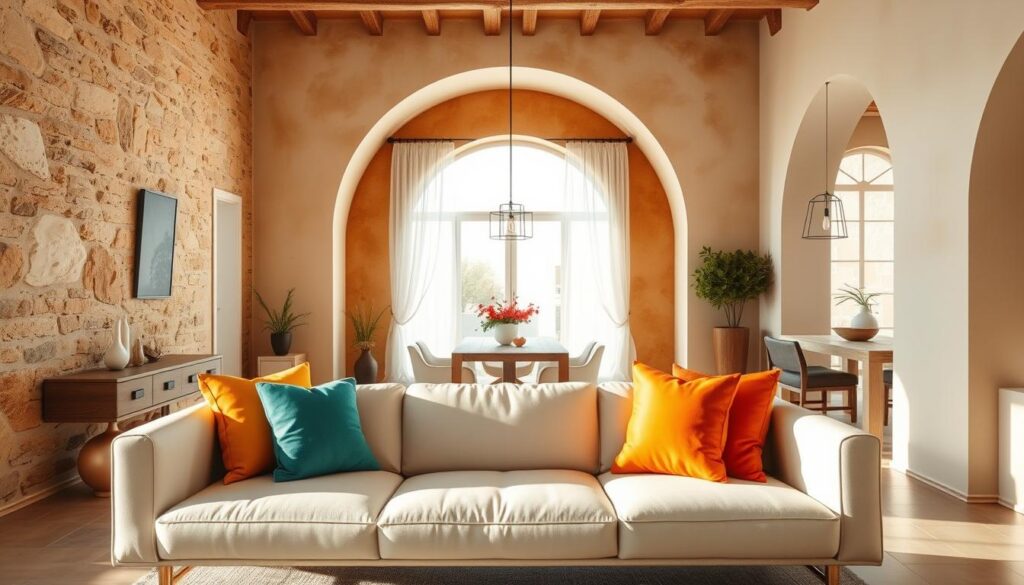
Balancing Old World Charm with Contemporary Needs
Integrating modern features into a Spanish-style home requires respect for its original charm. We can add modern appliances and tech in a way that fits the home’s traditional design.
For example, we can swap old lighting for new ones that still match the Spanish style. Updating kitchen appliances to be energy-efficient can also keep the kitchen’s look and feel.
Technology Solutions for Spanish Homes
Technology is key in making Spanish-style homes modern without losing their charm. Smart home systems can control lights, temperature, and security, making life better.
- Smart thermostats for efficient heating and cooling
- Automated lighting systems that adjust based on the time of day
- Home security systems that can be monitored remotely
Design Tips for Updating Without Losing Character
When updating a Spanish-style home, remember its original charm. Keep or restore features like wooden beams, decorative tiles, and ornate ironwork.
Design Tips:
- Use traditional materials in modern ways
- Incorporate modern technology discreetly
- Choose modern furnishings that complement the home’s style
By following these tips, we can make our Spanish-style home both beautiful and practical. It will blend traditional design with modern comforts perfectly.
Common Mistakes to Avoid in Spanish Design
Designing a Spanish-style home can be romantic. But, we must avoid common mistakes to make it authentic and beautiful. By knowing these pitfalls, we can create a stunning Spanish-style home that shows our personal taste.
Scale and Proportion Issues
Ignoring scale and proportion is a big mistake. Big, ornate pieces can make a room feel cramped. Small items might get lost. We need to balance our furniture and decor for a harmonious Spanish-style home.
Authenticity Matters
Not using authentic style elements is another mistake. Traditional materials like wrought iron and terra cotta keep the Spanish style true. Adding decorative tiles, textiles, and other features adds depth and character.
Misusing Color and Texture
Using colors and textures wrong can also ruin the Spanish style. Earthy tones, vibrant accents, and rich textures make a space warm and inviting. We must think about how these elements work together to avoid common mistakes.

